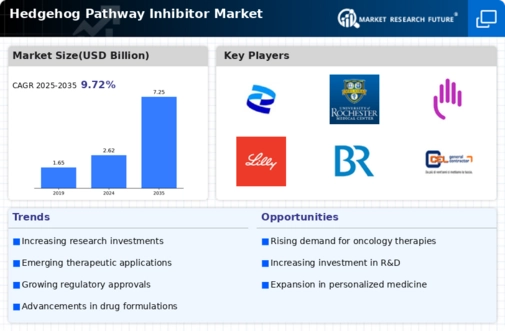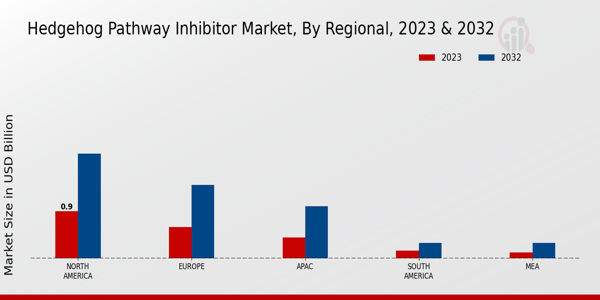Market Growth Projections
The Global Hedgehog Pathway Inhibitor Market Industry is projected to grow from 2.62 USD Billion in 2024 to 7.25 USD Billion by 2035, indicating a robust expansion. This growth trajectory is underpinned by a compound annual growth rate (CAGR) of 9.7% from 2025 to 2035, reflecting the increasing demand for targeted cancer therapies. The market's expansion is likely to be driven by advancements in drug development, increased research funding, and growing awareness of the efficacy of Hedgehog inhibitors in treating various malignancies.
Increased Research Funding
The Global Hedgehog Pathway Inhibitor Market Industry benefits from increased research funding aimed at understanding the Hedgehog signaling pathway's role in various diseases. Government and private sector investments are fostering innovation and accelerating the development of new inhibitors. For example, the National Institutes of Health (NIH) has allocated substantial resources to cancer research, which includes studies on Hedgehog inhibitors. This influx of funding is likely to enhance the pipeline of new therapies, thereby expanding the market's potential and contributing to the anticipated growth trajectory.
Rising Incidence of Cancer
The Global Hedgehog Pathway Inhibitor Market Industry is experiencing growth due to the increasing incidence of various cancers, particularly basal cell carcinoma and medulloblastoma. As cancer cases rise, the demand for targeted therapies, including Hedgehog pathway inhibitors, is expected to increase. For instance, the global cancer burden is projected to reach 29.5 million new cases by 2040, highlighting the urgent need for effective treatment options. This trend suggests that the market could expand significantly, with projections indicating a market value of 2.62 USD Billion in 2024 and a potential increase to 7.25 USD Billion by 2035.
Advancements in Drug Development
Innovations in drug development are propelling the Global Hedgehog Pathway Inhibitor Market Industry forward. The introduction of novel inhibitors, such as vismodegib and sonidegib, showcases the potential of targeting the Hedgehog signaling pathway in cancer therapy. These advancements not only enhance treatment efficacy but also improve patient outcomes, thereby increasing the adoption of these therapies. As research continues to unveil new applications for Hedgehog inhibitors, the market is likely to witness a compound annual growth rate (CAGR) of 9.7% from 2025 to 2035, reflecting the growing confidence in these therapeutic options.
Regulatory Approvals and Support
Regulatory approvals for Hedgehog pathway inhibitors are playing a crucial role in shaping the Global Hedgehog Pathway Inhibitor Market Industry. The swift approval processes by regulatory bodies, such as the U.S. Food and Drug Administration (FDA), for drugs like vismodegib and sonidegib have facilitated their entry into the market. This regulatory support not only boosts investor confidence but also encourages pharmaceutical companies to invest in the development of new inhibitors. As more products gain approval, the market is likely to expand, aligning with the projected growth figures.
Growing Awareness of Targeted Therapies
There is a growing awareness among healthcare professionals and patients regarding the benefits of targeted therapies, which is positively impacting the Global Hedgehog Pathway Inhibitor Market Industry. As more information becomes available about the efficacy and safety of Hedgehog inhibitors, healthcare providers are increasingly incorporating these treatments into clinical practice. This trend is further supported by educational initiatives and clinical guidelines that emphasize the importance of personalized medicine. Consequently, the market is expected to see a rise in adoption rates, contributing to its projected growth.














